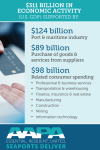Ports Prepare for an Uncertain Future
 For ports, looking ahead is a serious business. They have to build enough flexibility into their long-term planning and preparations to be ready for a variety of possible scenarios – and not just build for the moment.
For ports, looking ahead is a serious business. They have to build enough flexibility into their long-term planning and preparations to be ready for a variety of possible scenarios – and not just build for the moment.
* By Mary Lou Jay *
Speculating about the future can be fun – will we ever get those flying cars? For Western Hemisphere ports, however, looking ahead is a serious business. They have to build enough flexibility into their long-term planning and preparations to be ready for a variety of possible scenarios.
“As a business entity, we are first going to look at what are some of the anticipated changes in the flow of goods,” said Richard Sinkoff, director of environmental programs and planning at the Port of Oakland. “What are the effects of tariffs, what are the effects of regulation?” Changes in consumer purchasing habits will affect the goods that move through the port. Trends in the shipping alliances will shape its future operations.
One of the most pressing issues is climate change. The Port of Oakland is currently conducting a vulnerability assessment of all of its waterfront assets, assuming that sea levels will rise 1 foot by 2030, 2 feet by 2050 and 5.5 feet by 2100. By identifying and addressing the weakest links – the lowest lying areas – the port will increase its overall resiliency.
Sinkoff said the port’s high wharves should protect cargo loading and unloading operations and the warehouses and rail areas behind them. The most vulnerable area, likely to be addressed first, is a former U.S. Army base located close to the touchdown of the San Francisco/Oakland Bay Bridge. One solution could be building green infrastructure like a shallow water habitat area that can attenuate wave actions.
In other areas like marine terminals, the solution will probably be building higher wharf faces, piers and pilings.
“There’s no question there’s a sense of urgency, but at the same time we’re trying to make this a manageable project because there’s a great deal of engineering that has to be done, and there’s a lot of rebuilding that has to be done,” said Sinkoff.
To mitigate the severity of climate change, the port has adopted a new long-term air quality plan. “Our vision for the next 20 to 30 years is to move our equipment from carbon-based to a zero emissions profile,” Sinkoff explained. They’re already replacing existing diesel gantry cranes with hybrid electric cranes and using electric yard trucks instead of diesel.


